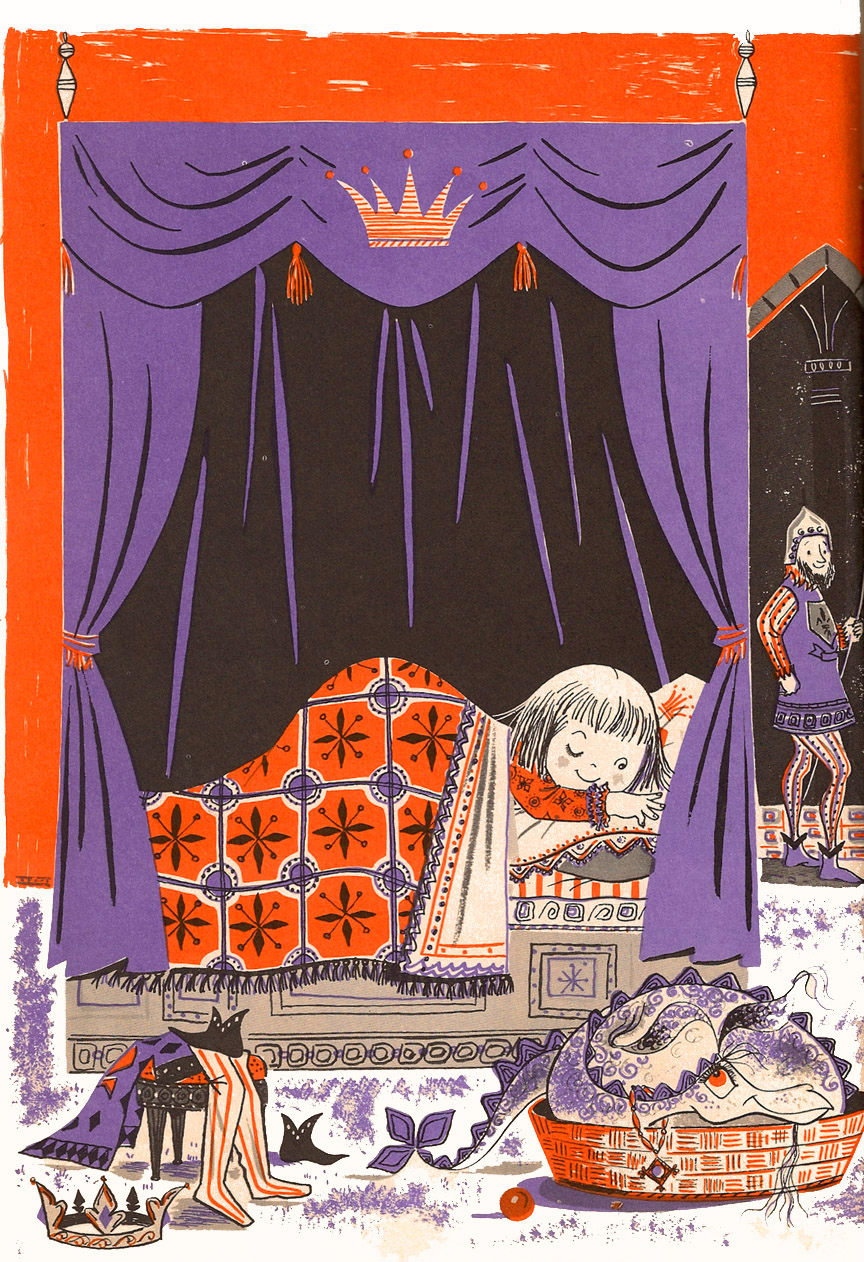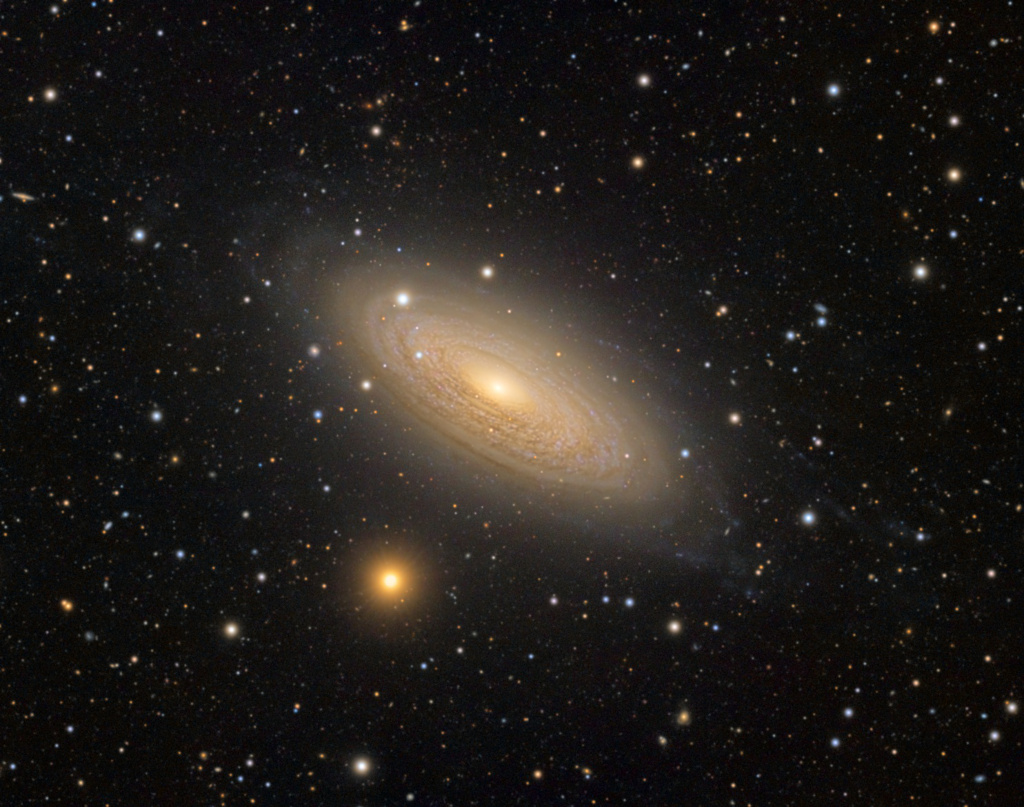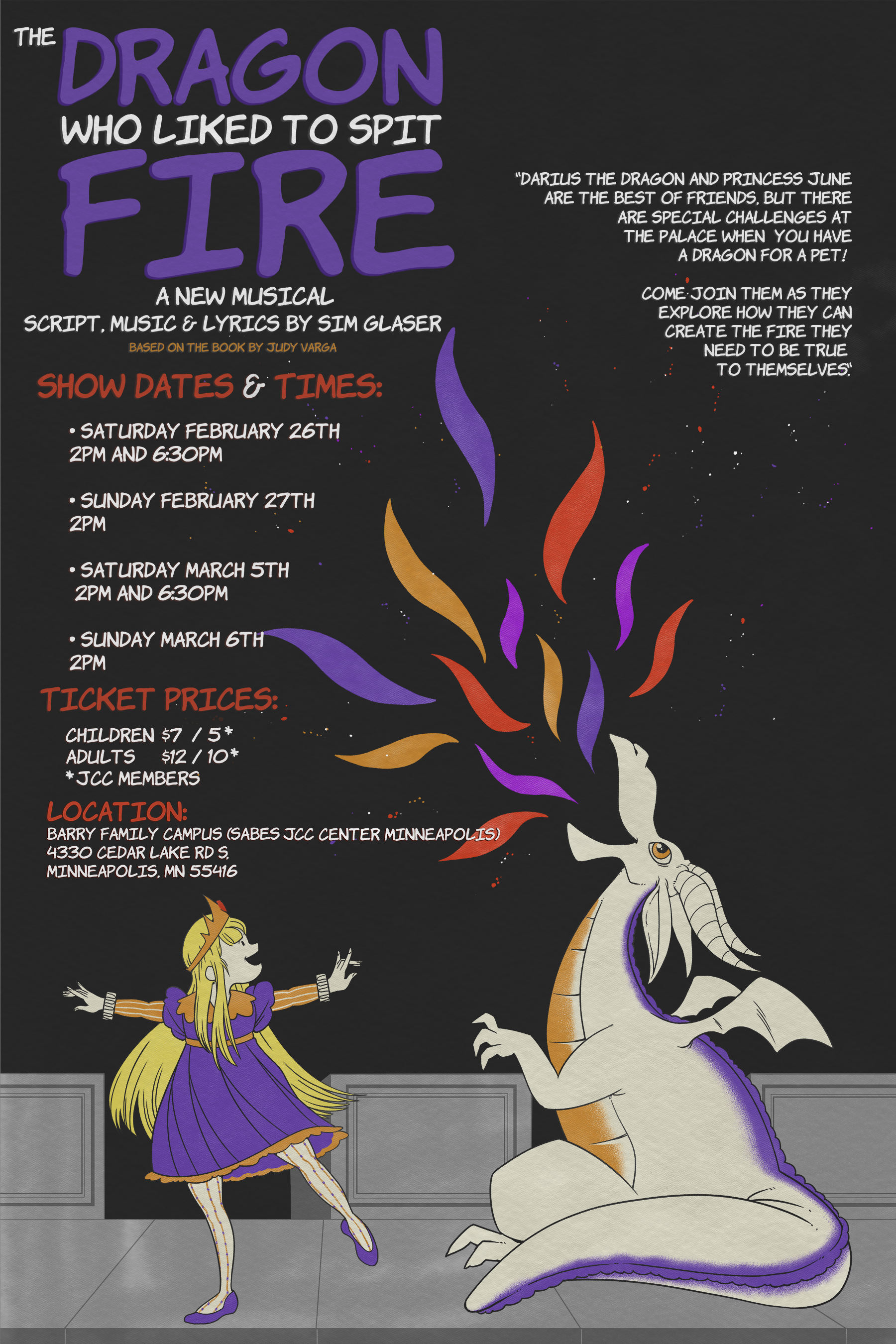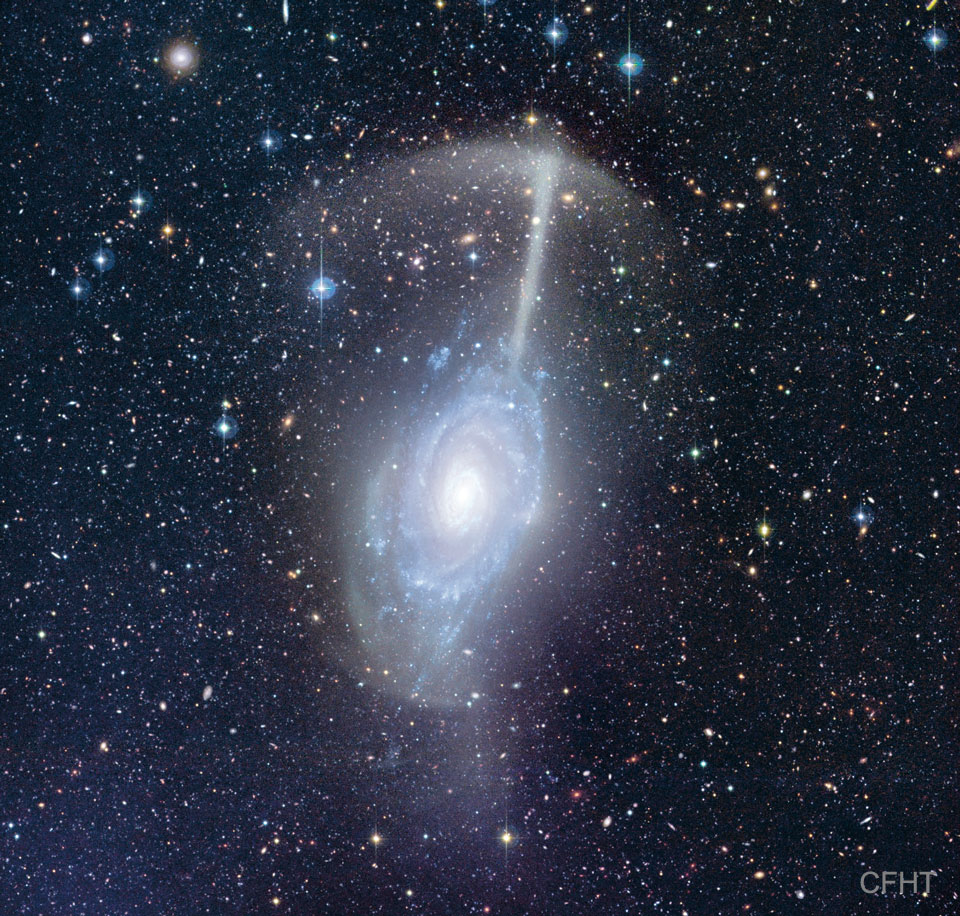Blog
Rhumba flamenco with Corazon del Flamenco in Odessa
more...Thursday March 3rd 10am matinee FREE ADMISSION today only. JCC St Louis Park. Music with Todd Russell, Riley Helgeson, Mark Yannie, Tom Lewis and mick laBriola.

A mere 46 million light-years distant, spiral galaxy NGC 2841 can be found in the northern constellation of Ursa Major. This deep view of the gorgeous island universe was captured during 32 clear nights in November, December 2021 and January 2022. It shows off a striking yellow nucleus, galactic disk, and faint outer regions. Dust lanes, small star-forming regions, and young star clusters are embedded in the patchy, tightlywound spiral arms. In contrast, many other spirals exhibit grand, sweeping arms with large star-forming regions. NGC 2841 has a diameter of over 150,000 light-years, even larger than our own Milky Way. X-ray imagessuggest that resulting winds and stellar explosions create plumes of hot gas extending into a halo around NGC 2841.

John Primer (born March 5, 1945, Camden, Mississippi, United States) is an American Chicago blues and electric blues singer and guitarist who played behind Junior Wells in the house band at Theresa’s Lounge and as a member of the bands of Willie Dixon, Muddy Waters and Magic Slimbefore launching an award-winning career as a front man, carrying forward the traditional Windy City sound into the 21st century.
Born into a family of Mississippi sharecroppers, Primer grew up imbued with a strong work ethic from his forebears and in a farming community that was deeply involved in the blues tradition, singing work songs in the field during the week and spirituals in church on Sundays. Living on the Mansell Plantation in rural Madison County, he lived in a shack with no running water and a leaking roof with his large, extended family. He shared a bed with cousins, and lost his father at age 22 after a truck accident when he was four years old.
more...Dupree Bolton (3 March 1929 – 5 June 1993) was a jazz trumpeter from Oklahoma City, Oklahoma, known for his recordings with Harold Land and Curtis Amy.
Dupree Bolton was born in Oklahoma City, Oklahoma on 3 March 1929. His father was likewise a musician who earned a meager living working in the defense industry. The Bolton family later moved to Southern California where Dupree spent most of his childhood and teenage years. Dupree picked up the trumpet at an early age, becoming a professional musician by the time he was around 15 – running away from home to join Jay McShann’s band.
more...James Emory Garrison (March 3, 1934 – April 7, 1976) was an American jazz double bassist. He is best remembered for his association with John Coltrane from 1961 to 1967.
Garrison was raised in both Miami and Philadelphia where he learned to play bass. Garrison came of age in the 1950s Philadelphia jazz scene, which included fellow bassists Reggie Workman and Henry Grimes, pianist McCoy Tyner and trumpeter Lee Morgan. Between 1957 and 1962, Garrison played and recorded with trumpeter Kenny Dorham; clarinetist Tony Scott; drummer Philly Joe Jones; and saxophonists Bill Barron, Lee Konitz, and Jackie McLean, as well as Curtis Fuller, Benny Golson, Lennie Tristano, and Pharoah Sanders, among others. In 1961, he recorded with Ornette Coleman, appearing on Coleman’s albums Ornette on Tenor and The Art of the Improvisers. He also worked with Walter Bishop, Jr. and Cal Massey during the early years of his career.
more...Arthel Lane “Doc” Watson (March 3, 1923 – May 29, 2012) was an American guitarist, songwriter, and singer of bluegrass, folk, country, blues, and gospel music. Watson won seven Grammy awards as well as a Grammy Lifetime Achievement Award. Watson’s fingerstyle and flatpicking skills, as well as his knowledge of traditional American music, were highly regarded. Blind from a young age, he performed publicly both in a dance band and solo, as well as for over 15 years with his son, guitarist Merle Watson, until Merle’s death in 1985 in an accident on the family farm.
Watson was born in Deep Gap, North Carolina. According to Watson on his three-CD biographical recording Legacy, he got the nickname “Doc” during a live radio broadcast when the announcer remarked that his given name Arthel was odd and he needed an easy nickname. A fan in the crowd shouted “Call him Doc!”, presumably in reference to the literary character Sherlock Holmes‘s companion, Doctor Watson. The name stuck.
An eye infection caused Watson to lose his vision before his second birthday. He attended North Carolina’s school for the blind, the Governor Morehead School, in Raleigh, North Carolina.
more...Free Admission Wednesday 3-2-22 10am matinee @ the JCC St Louis Park. Youtube video filming. Music with Todd Russell, Riley Helgeson, Mark Yannie, Tom Lewis and mick laBriola.
Last month, the Sun produced the largest prominence ever imaged together with a complete solar disk. The record image, featured, was captured in ultraviolet light by the Sun-orbiting Solar Orbiter spacecraft. A quiescent solar prominence is a cloud of hot gas held above the Sun’s surface by the Sun’s magnetic field. This solar prominence was huge — spanning a length rivaling the diameter of the Sun itself. Solar prominences may erupt unpredictably and expel hot gas into the Solar System via a Coronal Mass Ejection (CME). When a CME strikes the Earth and its magnetosphere, bright auroras may occur. This prominence did produce a CME, but it was directed well away from the Earth. Although surely related to the Sun’s changing magnetic field, the energy mechanism that creates and sustains a solar prominence remains a topic of research.

Lewis Allan Reed (March 2, 1942 – October 27, 2013 NY, NY) was an American musician, singer, songwriter, and poet. He was the guitarist, singer, and principal songwriter for the rock band the Velvet Underground and had a solo career that spanned five decades. The Velvet Underground was not a commercial success during its existence, but became regarded as one of the most influential bands in the history of underground and alternative rock music. Reed’s distinctive deadpan voice, poetic and transgressive lyrics, and experimental guitar playing were trademarks throughout his long career.
After leaving the band in 1970, Reed released twenty solo studio albums. His second, Transformer (1972), was produced by David Bowie and arranged by Mick Ronson, and brought him mainstream recognition. The album is considered an influential landmark of the glam rock genre, anchored by Reed’s most successful single, “Walk on the Wild Side“. After Transformer, the less commercial but critically acclaimed Berlinpeaked at No. 7 on the UK Albums Chart. Rock ‘n’ Roll Animal (a live album released in 1974) sold strongly, and Sally Can’t Dance (1974) peaked at No. 10 on the Billboard 200; but for a long period after, Reed’s work did not translate into sales, leading him deeper into drug addiction and alcoholism. Reed cleaned up in the early 1980s, and gradually returned to prominence with The Blue Mask and New Sensations(1984), reaching a critical and commercial career peak with his 1989 album New York.
Reed participated in the re-formation of the Velvet Underground in the 1990s, and made several more albums, including a collaboration album with John Cale titled Songs for Drella which was a tribute to their former mentor Andy Warhol. Magic and Loss (1992) would become Reed’s highest-charting album on the UK Albums Chart, peaking at No. 6.
He contributed music to two theatrical interpretations of 19th century writers, one of which he developed into an album titled The Raven. He married his third wife Laurie Anderson in 2008, and recorded the collaboration album Lulu with Metallica. He died in 2013 of liver disease. Reed has been inducted into the Rock and Roll Hall of Fame twice; as a member of the Velvet Underground in 1996 and as a solo act in 2015.
more...William Rory Gallagher (/ˈrɔːri ˈɡæləhər/ GAL-ə-hər; 2 March 1948 – 14 June 1995) was an Irish blues and rock guitarist, singer, songwriter, and producer. Born in Ballyshannon, County Donegal, and brought up in Cork, Gallagher formed the band Taste in the late 1960s and recorded solo albums throughout the 1970s and 1980s. His albums have sold over 30 million copies worldwide. Gallagher received a liver transplant in 1995, but died of complications later that year in London at the age of 47.
more...Larry Eugene Carlton (born March 2, 1948) is an American guitarist who built his career as a studio musician in the 1970s and 1980s for acts such as Steely Dan and Joni Mitchell. He has participated in thousands of recording sessions, recorded on hundreds of albums in many genres, for television and movies, and on more than 100 gold records. He has been a member of the jazz fusion group the Crusaders, the smooth jazz band Fourplay, and has maintained a long solo career.
Carlton was born in Torrance, California, United States, and at the age of six began guitar lessons. His interest in jazz came from hearing guitarist Joe Pass on the radio. From Pass he moved on to jazz guitarists Barney Kessel and Wes Montgomery and blues guitarist B.B. King. He went to junior college and Long Beach State College while playing professionally at clubs in Los Angeles. During the 1970s, he found steady work as a studio musician on electric and acoustic guitar in a variety of genres: pop, jazz pop, rock, rhythm and blues, soul and country. Carlton appeared on hundreds of recording sessions with Steely Dan, Joni Mitchell, Linda Ronstadt, Michael Jackson, Quincy Jones, Bobby Bland, Sammy Davis, Jr., Paulinho Da Costa, Charly García, the Fifth Dimension, Herb Alpert, Christopher Cross, Dolly Parton, Andy Williams, and the Partridge Family. Carlton performed on Mike Post‘s 1981 “Theme from Hill Street Blues.
more...
Edward F. Davis (March 2, 1922 – November 3, 1986), known professionally as Eddie “Lockjaw” Davis, was an American jazz tenor saxophonist.
Davis played with Cootie Williams, Lucky Millinder, Andy Kirk, Eddie Bonnemère, Louis Armstrong, and Count Basie, as well as leading his own bands and making many recordings as a leader. He played in the swing, bop, hard bop, Latin jazz, and soul jazz genres. Some of his recordings from the 1940s also could be classified as rhythm and blues.
His 1946 band, Eddie Davis and His Beboppers, featured Fats Navarro, Al Haig, Huey Long, Gene Ramey and Denzil Best.
In the 1950s, he was playing with Sonny Stitt, while from 1960 to 1962, he and fellow tenor saxophonist Johnny Griffin led a quintet. From the mid-1960s, Davis and Griffin also performed together as part of the Kenny Clarke/Francy Boland Big Band, along with other, mainly European, jazz musicians.
Davis died of Hodgkin’s lymphoma in Culver City, California, at the age of 64.
more...FREE ADMISSION March 2nd & 3rd Wednesday & Thursday Matinees 10am at JCC St Louis Park. Music with Todd Russell, Riley Helgeson, Mark Yannie, Tom Lewis and mick laBriola.

The main galaxy, spiral galaxy NGC 4651, is about the size of our Milky Way, while its stellar parasol appears to extend some 100 thousand light-years above this galaxy’s bright disk. A small galaxy was likely torn apart by repeated encounters as it swept back and forth on eccentric orbits through NGC 4651. The remaining stars will surely fall back and become part of a combined larger galaxy over the next few million years. The featured image was captured by the Canada-France-Hawaii Telescope(CFHT) in Hawaii, USA. The Umbrella Galaxy lies about 50 million light-years distant toward the well-groomed northern constellation Coma Berenices.

More Posts
- No ICE
- Cosmo M1
- Mahmoud Ahmed
- Keith Jarrett
- Mary Lou Williams
- Robert Johnson
- World Music Kevin Qamaniq-Mason
- Daily Roots Montana
- The Drummers Path
- Bumble Bee Slim
- KARIBUNI Benedictine Living New Brighton performance
- Cosmo M81/82
- Bill Kreutzmann
- Jimmy Ruffin
- Nexhmije Pagarusha
- Pyotr Ilyich Tchaikovsky
- Johannes Brahms
- World Music Western Jazz Band
- Daily Roots Sir P.J.
- MAYDAY 2025 Congero